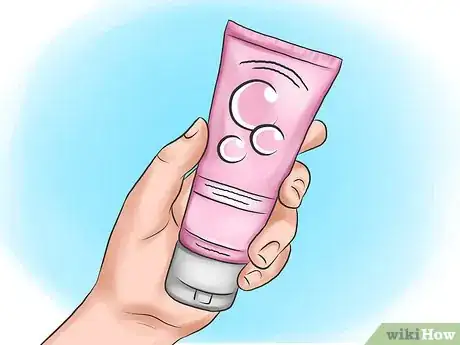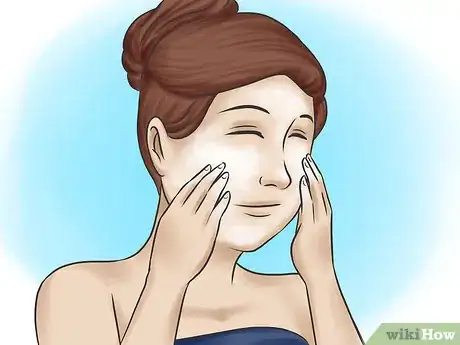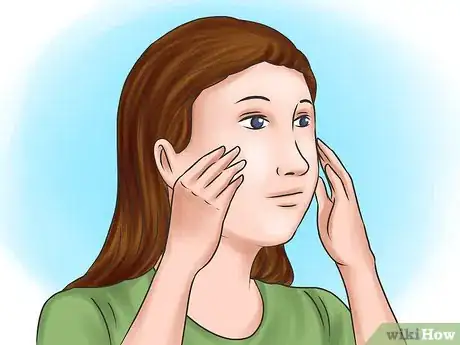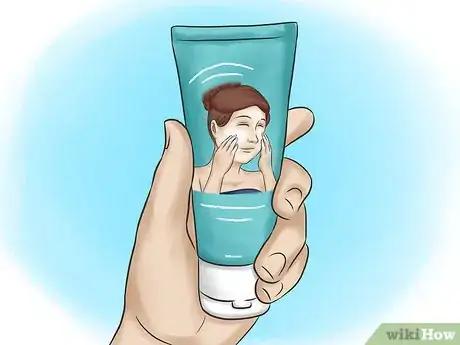This article was co-authored by Kaveri Karhade, MD. Dr. Kaveri Karhade is a board certified Laser, Medical, and Cosmetic Dermatologist in the San Francisco Bay Area. Her areas of expertise are acne and hair loss. She has advanced training in injectables, lasers, surgery, and other cosmetic treatments, and has published extensive research in medical journals. She holds a BS from Michigan State University and a Doctor of Medicine (MD) from the University of Michigan Medical School. She completed her internship in Internal Medicine at New York University School of Medicine and her Residency in Dermatology at Brown University School of Medicine. Dr. Karhade is a fellow of the American Academy of Dermatology and a member of the American Society for Dermatologic Surgery.
There are 24 references cited in this article, which can be found at the bottom of the page.
wikiHow marks an article as reader-approved once it receives enough positive feedback. In this case, 93% of readers who voted found the article helpful, earning it our reader-approved status.
This article has been viewed 440,880 times.
Babies are born with famously soft, smooth skin. As we age, we expose our faces to harsh conditions that rob skin of its softness. Combining a healthy lifestyle with the right skin care regimen will help to heal your skin and protect it from further damage.
Steps
Keeping Your Skin Healthy
-
1Protect your skin from sun damage. Wear sunscreen, moisturizer, or makeup with an SPF of 15 or higher to prevent premature aging. Contrary to popular belief, darker skin is also vulnerable to sun damage even if it doesn't burn as quickly as lighter skin. Always exercise caution no matter your skin tone.[1]
-
2Stay hydrated. Hydration keeps your skin supple and smooth. Women should drink at least 9 cups of water each day. Men should consume a little more at 13 cups daily.[2] Avoid coffee and alcohol, which have dehydrating effects. If you do partake, drink at least an extra cup of water for every cup of coffee or drink of alcohol.[3]Advertisement
-
3Eat a balanced diet. Your skin is your body's biggest organ and needs the right nutrients to stay soft and healthy. A diet rich in "good fats" like omega-3 fatty acids will help your skin to produce hydrating natural oils and prevent inflammation. The foods richest in omega-3s include fish, eggs, nuts, dairy, and brussel sprouts. If your skin is prone to roughness and breakouts, you may have a minor food allergy.[4]
-
4Improve your air quality. Skin is constantly exposed to the outside air. Smoke damages and dries out your skin. Because you breathe through your mouth and nose, these effects are magnified on your facial skin. Avoid working and living in smoke-filled environments. If you smoke tobacco, quitting will have an almost immediate effect on your skin's softness and will prevent premature aging.
- Consider adding a humidifier to your bedroom during the winter or if you live in a dry climate. Dry air will sap your skin of moisture and softness.[5]
Washing Your Face
-
1Find the right facial skin cleanser. Bar soap may do in a pinch, but many soaps can dry out your skin. Your face is more sensitive than the rest of your body and may need a special product to keep it soft and healthy. Pick a moisturizing cleanser if your skin is especially prone to dryness. If your skin is oily, choose a cleanser designed for oily skin. Use a makeup remover when washing off makeup.[6]
-
2Wash your hands before you begin. Your fingers are likely much dirtier than your face. Keep grime and bacteria away by quickly washing your hands with soap and water. If your skin is especially sensitive, you can use a little bit of your facial cleanser instead.[7]
-
3Apply the cleanser with your fingers. Place a dime-sized dollop of facial cleanser on your fingertips. Massage the cleanser onto your face with small, circular motions. Focus on the T-zone of your face, which includes your forehead, nose, and chin. Follow the directions on the package if they differ.
-
4Rinse with warm water. Splash lukewarm water on your face a few times to remove the cleanser. Cold water will not clean your face effectively. Hot water will dry your face out, reducing softness.[8]
-
5Pat dry with a towel. Use gentle up-and-down dabbing motions. Rubbing can potentially irritate your skin. It can also remove rejuvenating components of your cleanser that are meant to soak into your skin.[9]
-
6Massage in some moisturizer. Moisturizer is crucial for soft skin if yours is prone to dryness. As with your cleanser, massage a dime-sized dollop of product onto your face. Focus the lotion onto the driest areas of your face.[10]
- Try using a face cream that includes hydrating ingredients like hyaluronic acid and ceramides. These will give your face a softer, more moisturized feel.[11]
-
7Wash your face twice daily. Cleanse your face both after waking up and before going to bed. If you wear makeup, be sure to never sleep with it on.
- Washing too often can irritate your skin and strip it of its natural hydrating oils.
- Add an extra face wash every time you swim or work up a sweat.[12]
Exfoliating Your Skin
-
1Find the exfoliating product that is right for your skin. As with cleansers, there are many different products on the market available for different skin types. You will likely need to find yours through trial and error. In general, if your skin is oily, look for exfoliating products that promise a "deep cleanse." If your skin is dry, find one that is gentle and moisturizing.[13]
-
2Massage the product onto your skin with your fingers. Work up your face slowly, moving your fingertips in small circular motions.
- Gentle scrubbing microfiber towels are an alternative to massaging in by hand. Many beauty shops even sell gloves made of this material to make your routine easier.
- Electric-powered exfoliating tools are also popular. Inexpensive versions of these gadgets can be found at most supermarkets.[14]
-
3Rinse the product off and pat your face dry. Use warm water. Avoid rubbing your skin with a towel, as this can irritate and damage your skin. Your skin may be more sensitive after exfoliating.[15]
-
4Moisturize your face. Moisturizing is especially important after exfoliating, as natural hydrating oils are often stripped away in the process. Exfoliating also removes your skin's first layer of protection. While dead, dry skin may make your skin feel rough, it does serve as a barrier over more sensitive skin underneath.[16]
-
5Repeat twice a week before bed. Regular exfoliating helps to keep your skin soft and blemish-free. You can reduce frequency if the humidity goes up or your skin is less prone to flaking. If your skin is very sensitive, exfoliating may be too irritating and worsen dryness. Find the right balance that works for you.[17]
Shaving Your Face
-
1Make sure your razor is sharp before you begin. Shaving with a dull blade irritates your skin, causing bumps.[18]
- Even women without obvious facial hair can benefit from the smoothing effects of shaving. Don't worry about your peach fuzz growing back thicker and darker; that's an old wives' tale. Dermaplaning is a popular type of exfoliation where the upper layer of dead skin is removed from the face with a sharp blade.[19]
-
2Apply a generous amount of shaving preparation. Make sure to massage it into your skin for the closest shave possible.[20] There are five major types of shaving preparations:
- Shaving creams must be lathered with fingers or a shaving brush. These are considered to be the most popular among professional barbers.
- Shaving gels are similar to shaving creams but are a little easier to apply.
- Shaving foams are what most people think of as "shaving creams." They come out of the can ready to use with no need to lather.
- Shaving soaps are solid soaps that must be whipped into a lather with a shaving brush.
- Shaving oils can be used alone or underneath shaving cream. Oils are best for those with sensitive, dry skin.[21]
-
3Rinse your razor after each stroke. When your razor is clogged with hair, it becomes effectively dulled. The clogged razor will not be as effective and may cause razor bumps. Heat can also cause a blade to dull more quickly.[22]
-
4Rinse your face with cold water. Cold water prevents skin irritation. The cold will close your skin's pores, protecting them from any negative effects of your aftershave. It also tightens the skin, keeping ingrown hairs from occurring.[23]
-
5Dab on alcohol-free aftershave. Use your fingertips to apply the aftershave to freshly shaved skin. Aftershave lotions and gels work as moisturizers to rehydrate your skin and keep it soft. Some lotions also contain ingredients that soothe irritated skin.
- Traditional alcohol-based aftershaves dry out your skin, potentially leaving you with a rough face.[24]
Expert Q&A
Did you know you can get expert answers for this article?
Unlock expert answers by supporting wikiHow
-
QuestionHow do I make my face softer?
 Kaveri Karhade, MDDr. Kaveri Karhade is a board certified Laser, Medical, and Cosmetic Dermatologist in the San Francisco Bay Area. Her areas of expertise are acne and hair loss. She has advanced training in injectables, lasers, surgery, and other cosmetic treatments, and has published extensive research in medical journals. She holds a BS from Michigan State University and a Doctor of Medicine (MD) from the University of Michigan Medical School. She completed her internship in Internal Medicine at New York University School of Medicine and her Residency in Dermatology at Brown University School of Medicine. Dr. Karhade is a fellow of the American Academy of Dermatology and a member of the American Society for Dermatologic Surgery.
Kaveri Karhade, MDDr. Kaveri Karhade is a board certified Laser, Medical, and Cosmetic Dermatologist in the San Francisco Bay Area. Her areas of expertise are acne and hair loss. She has advanced training in injectables, lasers, surgery, and other cosmetic treatments, and has published extensive research in medical journals. She holds a BS from Michigan State University and a Doctor of Medicine (MD) from the University of Michigan Medical School. She completed her internship in Internal Medicine at New York University School of Medicine and her Residency in Dermatology at Brown University School of Medicine. Dr. Karhade is a fellow of the American Academy of Dermatology and a member of the American Society for Dermatologic Surgery.
Board Certified Dermatologist
References
- ↑ http://www.cancer.org/cancer/cancercauses/sunanduvexposure/skincancerpreventionandearlydetection/skin-cancer-prevention-and-early-detection-sun-damage
- ↑ http://www.mayoclinic.org/healthy-lifestyle/nutrition-and-healthy-eating/in-depth/water/art-20044256
- ↑ http://youqueen.com/beauty/skin-care/9-steps-to-make-your-skin-soft/
- ↑ http://www.webmd.com/beauty/skin/want-healthy-skin-feed-well
- ↑ http://www.realsimple.com/beauty-fashion/skincare/skincare-face/strategies-for-better-skin
- ↑ http://www.instyle.com/news/5-steps-correctly-washing-your-face
- ↑ http://stylecaster.com/beauty-high/common-mistakes-washing-your-face
- ↑ http://stylecaster.com/beauty-high/common-mistakes-washing-your-face
- ↑ http://www.teenvogue.com/story/how-to-properly-wash-your-face
- ↑ http://www.seventeen.com/beauty/makeup-skincare/how-to/a11543/643161
- ↑ Kaveri Karhade, MD. Board Certified Dermatologist. Expert Interview. 5 January 2021.
- ↑ http://www.teenvogue.com/story/how-to-properly-wash-your-face
- ↑ http://www.webmd.com/beauty/skin/you-asked-exfoliation-products
- ↑ http://www.huffingtonpost.com/2015/05/12/exfoliate-face-how-to_n_2528493.html
- ↑ http://health.howstuffworks.com/skin-care/cleansing/tips/how-to-exfoliate-skin.htm
- ↑ http://stylecaster.com/beauty-high/common-mistakes-washing-your-face
- ↑ http://www.webmd.com/beauty/skin/you-asked-exfoliation-products
- ↑ http://uk.askmen.com/fashion/fashiontip_300/319_fashion_advice.html
- ↑ http://www.washingtonian.com/blogs/shoparound/hair-beauty/video-why-you-might-like-to-try-dermaplaning.php
- ↑ http://www.webmd.com/men/features/getting-close-shave
- ↑ http://www.fashionbeans.com/2013/mens-shaving-prep-guide
- ↑ http://sharpologist.com/2012/03/cold-water-shaving-2.html
- ↑ http://www.xovain.com/skin/preventing-and-treating-razor-burn
- ↑ http://www.mensjournal.com/health-fitness/grooming/a-users-guide-to-aftershave-20140423
- ↑ http://www.soapqueen.com/bath-and-body-tutorials/tips-and-tricks/jojoba-beads-vs-microbeads-whats-the-difference
- ↑ http://www.ewg.org/enviroblog/2013/02/natural-extracts-can-trigger-allergies
- ↑ http://www.treehugger.com/health/why-you-should-say-no-fragrance.html
About This Article
Skin naturally tends to get rougher and less smooth over time, but washing, exfoliating, and shaving regularly can help. Wash your face twice a day with a gentle facial cleanser, once in the morning and once before bed. Washing your face daily will keep your skin smooth by preventing breakouts. You should also exfoliate your skin with a face scrub or exfoliating tool twice a week. Exfoliating removes dead skin cells and reveals smooth, soft skin underneath. Shaving can also help your skin to feel silky smooth. Use a generous amount of shaving cream and rinse your face with cold water once you’re done to prevent skin irritation. For more advice on how to have a baby soft face, like lifestyle changes you can make to protect your skin in the long term, read on!






























-Step-12-Version-3.webp)
















































